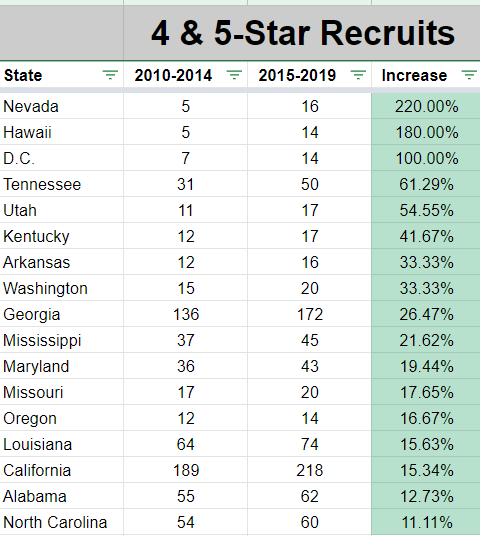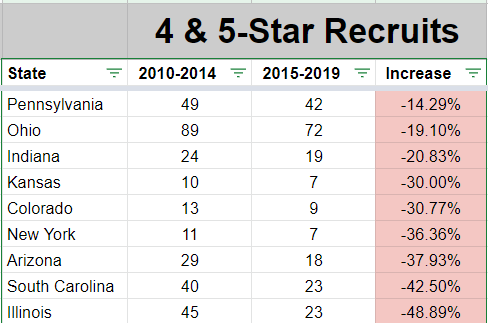The lifeblood of every college football program is recruiting. Not every program is blessed with a strong home-state recruiting base. Teams located in the south and along the Atlantic Ocean coastline have a tremendous recruiting advantage when it comes to homegrown talent. While teams located in the northeast and almost every state west of the Mississippi, outside of California and Texas, don’t consistently produce top talents coming out of high school.
I’ve compiled recruiting data dating from the 2010 recruiting class through the 2019 recruiting class. Using 247 Composite Rankings, I’ve been able to pinpoint the most talent-rich states and regions for college football recruiting. This does not include the current 2020 class that is signing this week due to rankings and stars not being finalized just yet.
A Tier Above the Rest:
The states of California, Florida, Georgia, and Texas have a clear grip atop of the most talent-rich states. During my 10-year sample size of recruiting rankings, these four states account for 54.6% of all 5-star recruits and 48.3% of all 4-star recruits during that time frame. Also, in those ten years, they tallied over 50% of all Top 50 and Top 100 recruits. Among this top tier, the state of Florida produces more 5-star, Top 50, Top 100, and Top 250 recruits than any other state. Those numbers are slightly skewed with IMG Academy bringing in top talent from all across the country in the last five years. Even without the addition of IMG Academy recruits, the state of Florida would still most likely be the top dog either way.
Top 100 Recruits by State

Out of the big four, Georgia is the biggest outlier. In terms of population, California, Florida, and Texas come in as the three most populated states in America. Georgia comes in at 8th with 10.6 million, while Florida has 21.1 million, Texas 29 million, and California with 39.7 million. Georgia more than holds its own despite the large discrepancy in size.
Recruits by Region:
The United States breaks down into seven regions.
– Mid-Atlantic Region: New York, New Jersey, and Pennsylvania
– New England Region: Maine, Rhode Island, Vermont, Connecticut, New Hampshire, and Massachusett
– Pacific Coastal Region: California, Oregon, and Washington
– Rocky Mountain Region: Montana, Idaho, Colorado, Utah, Wyoming and Nevada
– Southwest Region: Texas, Arizona, New Mexico, and Oklahoma
– Midwest Region: Michigan, North and South Dakota, Iowa, Minnesota, Kansas, Nebraska, Ohio, Indiana, Illinois, Wisconsin, and Missouri
– Southern Region: Virginia, West Virginia, Kentucky, Delaware, Maryland, North and South Carolina, Tennessee, Arkansas, Louisiana, Florida, Georgia, Alabama, and Mississippi
Once you see the breakdowns by region, you can easily see why the SEC and other southern schools are the most talented on a yearly basis. The southern region more than triples any other region in terms of producing 5-stars, 4-stars, Top 50, Top 100, and Top 250 recruits. Nearly 56% of all 5-star recruits come from the 14 southern states listed, which are heavily populated by SEC schools.
If you combine the New England Region and the Mid-Atlantic Region into one big Northeast Region, they barley combine for 5% of 5-star, 4-star, and Top 100 recruits. This easily can explain the difference in talent readily available for schools like Boston College, Connecticut, Syracuse, and the Pennsylvania schools compared to southern schools. The talent in the ten years for the entire Northeast Region is equal to just one year for the Southern Region in terms of 5-stars, 4-stars, and Top 50 recruits.
At one time, the Midwest Region dominated the college football world. With teams like Michigan, Nebraska, Notre Dame, and Ohio State that ran most of college football from the 70s through the 90s. The once talent-rich Midwest now only comes in fourth in terms of talent out of the seven regions. The south, on average, puts out 50 Top 100 recruits per year while the Midwest averages about 11 over the last ten years. That number was sitting at around 13 from 2010 through 2014. Still, from 2015 up through the 2019 recruiting class, the midwest is only putting out 8.5 Top 100 recruits per cycle, forcing northern powers like Michigan, Notre Dame, and Ohio State to focus more in the south to grab top recruits. Traditionally Midwest recruiting pipeline states like Illinois and Ohio have seen a steady decrease over the last five years in Top 100 recruits they output. While not technically in the Midwest Region, Pennsylvania, another traditionally feeder state for Big 10 schools has also seen a slight decrease as well. While southern states like Georgia, Louisiana, and Mississippi have seen an increase in the last five years for Top 100 recruits, even if you want to expand it out to producing Top 250 players, you see an even bigger decreases in recruits for Illinois, Ohio, and Pennsylvania while Georgia, Louisiana, and Mississippi see a bigger increase in recruits per year. As a whole, the Midwest Region has seen a decrease of nearly 20% of 4-stars produced from 2010-2014 to 2015-2019 recruiting cycles.

In the 2019 recruiting cycle, the Southern Region produced over 1,000 3-star recruits (this number continues to grow year over year for the last nine recruiting cycles) to the Midwest’s lowly 300 3-star recruits. Being able to land 3-star recruits is what sets apart top Group of 5 schools from the rest of the Group of 5. If you are wanting to build a G5 school up in hopes of grabbing a Power 5 gig, picking a G5 in the south would be the perfect launching point.
The Struggle Out West:
Talent west of the state of Texas lacks outside of the state of California. No states averages are more than 1 Top 100 recruit per year outside of Arizona, Missouri, Oklahoma, and Washington, who only combine for 46 total Top 100 recruits in the last ten recruiting cycles. Expanding out to Top 250 recruits, the states of Arizona, Missouri, Oklahoma, Utah, and Washington all barely make it into the top 25 of states that have produced the most Top 250 recruits in the last ten years. If you are located west of the Mississippi recruiting runs through California and Texas, no questions about it. Hawaii, Nevada, Oregon, and Utah have all seen a small surge in 4-star recruits over the last five recruiting cycles, but it still lacks much of a punch to support the west coast. All four states have seen an over 40% increase in 4-star recruits from 2010-2014 to 2015-2019 recruiting cycles.

Biggest Winners/Losers:
As I previously talked about, the Midwest Region has lost a tremendous amount of talent, and it all seems to be going down south. In terms of producing 4-star and 5-star recruits, the states of Pennsylvania, New Jersey, Indiana, Ohio, and Illinois have all seen a decrease of at least 10% of 4-star recruits from 2010-2014 to 2015-2019 recruiting cycles. All traditionally major recruiting grounds for Big 10 teams. While states like Mississippi, North Carolina, Alabama, Georgia, Louisiana, Kentucky, and Tennessee have all seen an increase of at least 10% in 4 and 5-star recruits produced during the same time frame. Even the already talent-rich state of Florida has seen an increase of 7.7% in 4-star recruits.

Having elite recruiting goes a long way into having an elite football team. Teams like Alabama, Clemson, LSU, Ohio State, and Oklahoma have all dominated the last decade of college football not it’s not surprising to see that they traditionally have the top recruiting classes each season. Having a talent-rich recruiting base goes a long way to having a top class. Schools in the Midwest, Northeast, and Northwest lack the raw number of high-level recruits. They are forced to dip into California, the South, and Texas to fill out their recruiting classes. With more top talent coming out of the south, I expect a continuation of the southern powers running college football.










